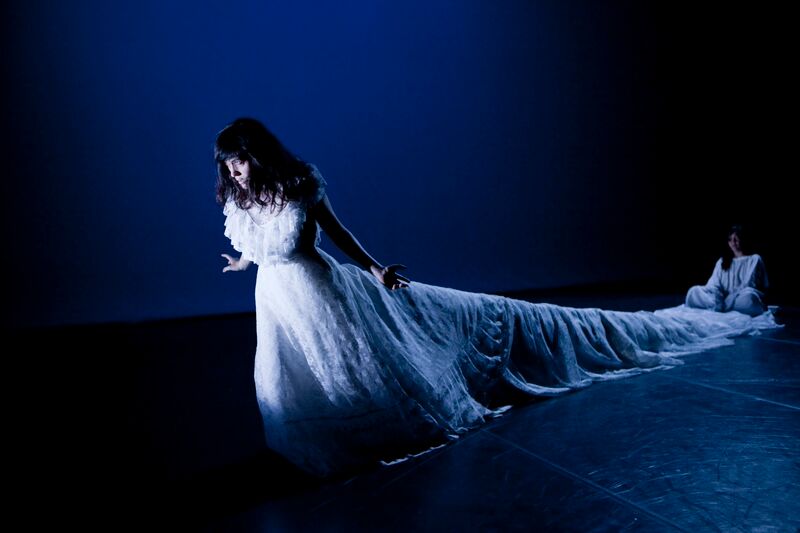L’Oublié(e) is a stunningly beautiful piece – a mostly monochrome series of moving pictures that blends contemporary circus, dance and word-free visual theatre, all accompanied by a highly inventive lighting design, and an eclectic soundspace that merges ambient electronica with echoing snatches of old-world waltzes, tangos and torch-songs. The 1930s classic Dream a Little Dream of Me is a recurring theme – incorporated into the soundtrack, and performed live, in a quavering little voice.
In this quasi-cinematic work, breathtakingly beautiful moving pictures follow one after the other as disorientating and surreal dream images emerge and dissolve from the darkness, often lit photographically with intense, focused white light. Sumptuous fabrics play a big part in the scenography – long fluttering curtains and veils waft and swing and are swung from. Faces and bodies are framed with light, and dissolve into a flickering darkness, like the fading stars of silent cinema. And here again comes the refrain ‘ dream a little dream of me’. But as the White Queen says to Alice: Who is dreaming whom?
As for form: Raphaëlle Boitel – multi-talented and versatile in every sense of the word – is principally a contortionist, so this circus art naturally features strongly, alongside aerial dance using silks and bungees (often in new and inventive ways). Wry humour has always been in evidence in her work, and here this is developed with a new maturity. The circus / aerial dance work is incorporated effortlessly into the work, acting as rich metaphor: a body levitates above a table, then seems to shrug off its mortal coil; a woman on a big band of elastic runs forward and is pulled back time and again, like a modern-day Sisyphus; a doctor examines a patient whose limbs refuse to stay where they should be.
Boitel’s previous work within contemporary circus-theatre is there to see in L’Oublié(e), her first major work as auteur/director. The time spent with James Thierrée’s Compagnie du Hanneton (she starred in both Junebug and La Veillee des Abysses) has borne fruit, revealed in the witty play with furniture (tables and chairs, in this instance) and furnishings; the air of surreal humour that pervades so many of the images; and an ongoing interest in the animus/anima theme – the all-consuming desire for male and female to re-unite, to find their other half that makes them whole. But to what extent this is James Thierrée’s influence is hard to say, as we could also see it as a shared visual and physical language that she, James and her brother Camille (also a renowned circus artist) developed together in all the years that they co-devised and presented work together.
There are other influences and predecessors in evidence: a touch of Pina Bausch here, a nod to David Lynch there. A dash of Kate Bush – and a great big shovelful of Philippe Genty.
Narrative is not the most important aspect of this work, but there is one of sorts: at the start, we see a man is on a hospital bed, perhaps in a coma, or after a heart attack, and a shadow theatre scenario of attempts to resuscitate him. A woman has been waiting for him to wake up, and we are then plunged into a parallel world of hallucinations and fantastical situations. Whether this is inside her head or his – or both – we never know for sure. We don’t know who he is and what their relationship might be – although it appears to be a romantic one.
Throughout, archetypes of womanhood are explored: Romantic heroines in voluptuous white dresses are swept off their feet; black widows trail their trains across the floor; shrouded figures float high in the space, like lost angels. In one scene, we are presented with a triad of female forms, a merging of the three female characters that suggests, as the mythology would have it, that the legendary three aspects of Demeter – maidenhood, womanhood, and maturity – are all carried in any one woman.
If there’s a criticism of the piece, it is that the narrative set up at the beginning is never resolved. We move into the world of subconscious dreams and fantasies, but we are not taken out of it, back to the hospital. We can only presume that the artist shied away from any resolution – but dramaturgically the piece feels incomplete, as we are left floating in the depths of the dream.
Thematically, it would seem to be exploring the very nature of what it means to be alive, and the fragility of the balance between life and death. It seems to be asking: where does memory end and imagination begin? Is the life of our dreams as important as our waking moments? And what does it mean to be a spirit living inside a body? No answers are given to these metaphysical conundrums – but we leave feeling a whole lot of interesting questions have been posed.

